
Voice of customer tools collect and analyze customer feedback, then turn it into data you can use to grow your business. Discover the best VoC tools on the market.

32% of customers say they would walk away after one bad experience. That’s why having an amazing customer experience is more important than ever. Businesses need to understand what their customers really think, and the best way to do this is a Voice of Customer (VoC) program.
Most businesses begin by sending out surveys and collating customer feedback which they can distill into actionable insights using analytics tools. With the right Voice of Customer tools, you can pinpoint exactly what your customers want and deliver a superior experience.
In this blog post, we’ll dive into what Voice of Customer (VoC) is and the benefits of using certain tools for your VoC program. Then we’ll take an in-depth look at the best VoC tools currently on the market and discuss how to choose the right tool for your business.
Voice of Customer (VoC) is your current and potential customers’ opinions and experiences about your product or service. It helps you understand the motivations, preferences, and pain points driving customer behavior.
Capturing VoC involves collecting and analyzing customer feedback through various channels. The most popular channels are:
The goal of collecting VoC is to capture customers’ requirements and to use these valuable insights to serve your customers better. VoC insights can help businesses to improve customer satisfaction, boost customer retention, and enhance profitability.
At a time when customer experience is king, Voice of the Customer helps companies stay competitive by keeping up with shifting customer needs and preferences.
Written by a CX expert, this handbook simplifies VoC strategies and helps you get the most from customer feedback.
What's inside:
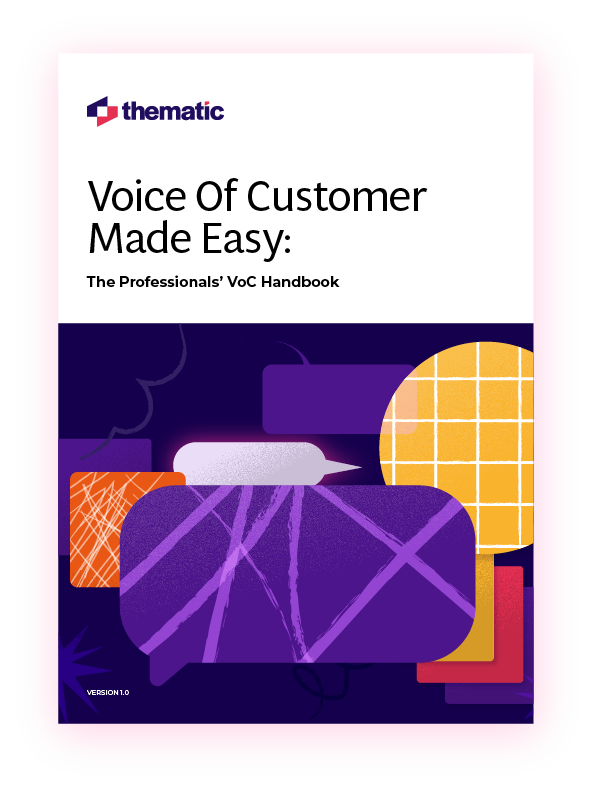
Let’s take a closer look at how VoC tools can benefit your business. According to this recent study, 61.2% of marketers said Voice of Customer programs increased their Net Promoter Score (NPS) and customer satisfaction.
Additionally, 37.9% reported increased customer retention and 33% received more referrals and positive word of mouth. A further 20.7% experienced increased spend or share of wallet.

Using VoC tools to collect customer feedback and obtain valuable insights can be a game-changer. Here’s some more ideas of how your organization can benefit from using them:
VoC tools let you gather targeted customer feedback on specific topics, offering valuable insights into their needs, preferences, and pain points. You can then use this information to tailor your product or service to exactly match your customers’ requirements.
Addressing customer feedback builds stronger connections and loyalty. When customers see their input lead to real improvements, they are more likely to stick with your brand. This in turn increases customer retention and spreads positive word-of-mouth.
Happy customers return and recommend your business. By using VoC insights to enhance the customer experience, you can drive more repeat purchases and increase long-term profits.
Stay ahead of the competition and differentiate yourself in the marketplace by keeping up to date with your ideal customer’s preferences. Adapting to changing customer needs keeps your brand relevant and distinct in a crowded market.
Voice of Customer tools are designed to make it as easy as possible to collect and analyze customer feedback from various sources. They use advanced analytics to categorize this data, uncovering key trends and patterns in customer behavior.
VoC tools can also segment feedback by customer demographics. This includes age, gender, location, and other variables, allowing you to spot trends within specific customer groups. You can then tailor products and services to better address customer needs and solve their problems.
Another essential feature of VoC tools is integrating feedback data with other business systems, such as CRM, marketing automation, and customer service platforms. This integration enables businesses to take a holistic view of customer interactions and identify opportunities to improve the overall experience.
Now we’ve explored why you need VoC tools and how they work, let’s take a look at the different types of tools currently available:
Survey-based VoC tools are among the most common methods for gathering customer feedback. These tools focus on collecting structured feedback directly from customers through surveys, questionnaires, and polls.
By asking targeted questions, businesses can gain specific insights into customer preferences, satisfaction levels, and expectations, which can then be distilled into actionable strategies.
Social listening tools monitor social media platforms, online forums, and review sites to capture customer sentiment in real-time. These tools allow businesses to understand how customers feel about their brand, products, or services based on what they’re saying online.
By tapping into unfiltered customer opinions, businesses can quickly identify trends, address concerns, and engage with customers where they’re most active.
Integrated VoC platforms combine various data sources, offering a holistic view of the customer experience. These platforms aggregate data from surveys, social media, customer support interactions, and more, providing a comprehensive picture of customer sentiment and behavior.
This integrated approach enables businesses to see the bigger picture and make informed decisions based on a wide array of customer inputs.
Advanced VoC analysis tools leverage AI and machine learning to enhance the depth and accuracy of customer insights. These tools can process large volumes of qualitative data quickly, identifying patterns and trends that might not be immediately apparent through traditional analysis.
By applying advanced analytics, businesses can predict customer expectations, personalize experiences, and continuously improve their VoC efforts.

When it comes to Voice of Customer (VoC) tools, there are a few key features that really set the great ones apart:
The best VoC tools gather feedback from all the places your customers hang out—surveys, social media, email, chats, and even reviews. This gives you a complete picture of how people feel about your brand across the entire customer journey.
The top tools on the market use smart analytics and AI to organize the data, spot patterns, and highlight trends. Users can quickly interpret large amounts of data and gain actionable insights that will really make a difference to their organization.
AI tools like Thematic are a great option since they automatically analyze your feedback and determine the main themes and sub-themes in your customer data. Thematic also performs sentiment analysis so you know exactly how your customers are feeling.
Effective VoC tools allow businesses to segment customer feedback by demographic factors like age, gender, location, and purchase behavior. This helps you see what different groups of customers want, so you can fine-tune your offerings to match their requirements.
Real-time data and easy-to-read dashboards keep you in the loop, so you can track customer feedback as it happens. This means you can quickly spot issues or opportunities and take action right away, as in the example below from Thematic.

Seamless integration with your existing tools, like CRM, marketing, or customer service platforms, is crucial. This way you get a 360-degree view of your customer interactions, making it easier to improve the overall experience.
Good VoC tools don’t just collect feedback. They help you act on it. Automated alerts can flag important customer comments, like complaints or suggestions, so you can respond quickly and effectively.
Successful Voice of Customer tools are flexible and customizable. You can adjust surveys, feedback forms, and reports to match your business needs, ensuring you get the insights that matter to you.
The right VoC tool can help you gather customer feedback from multiple sources, analyze customer sentiments, and integrate insights into your overall strategy. To find the best fit, you’ll need to think about your business goals, how the tool will fit into your operations, and what you’re willing to spend.
Here at Thematic, we help organizations power their Voice of Customer programs with our advanced AI analytics platform.
Melodics is an app that teaches you to play MIDI keyboards, pad controllers and drums. The company wanted to find out what really matters to their customers so they could improve their product roadmap. The team were spending hours manually analyzing their customer feedback and struggling to get useful insights.
The first step was to make sense of Melodics’ noisy unstructured feedback from several channels, including NPS survey responses, in app questions, and feedback from their support team. Melodics sent out a simple customer survey using SurveyGizmo which asked customers for a score of how likely they were to recommend the company to others and two open-ended questions.
Connecting this data to Thematic gave them deep insights into VoC feedback within days with little manual intervention from anyone at Melodics. Using the platform’s thematic analysis approach and clear visualizations, Thematic enabled Melodics to quantify the impact of specific feedback themes on the NPS score.

For example, the Melodics team learned that lag in the app greatly impacted the metrics (see above). These valuable customer insights showed Melodics exactly where they needed to focus their attention in the future.
Thematic’s powerful AI analytics tool is a great complement to any Voice of Customer program. Why not try out Thematic on your data with a free guided trial and see how it works for you.
Now we’ve explored what Voice of Customer tools can do for your business and how to choose the right one for you, let’s explore the top tools currently on the market by category:
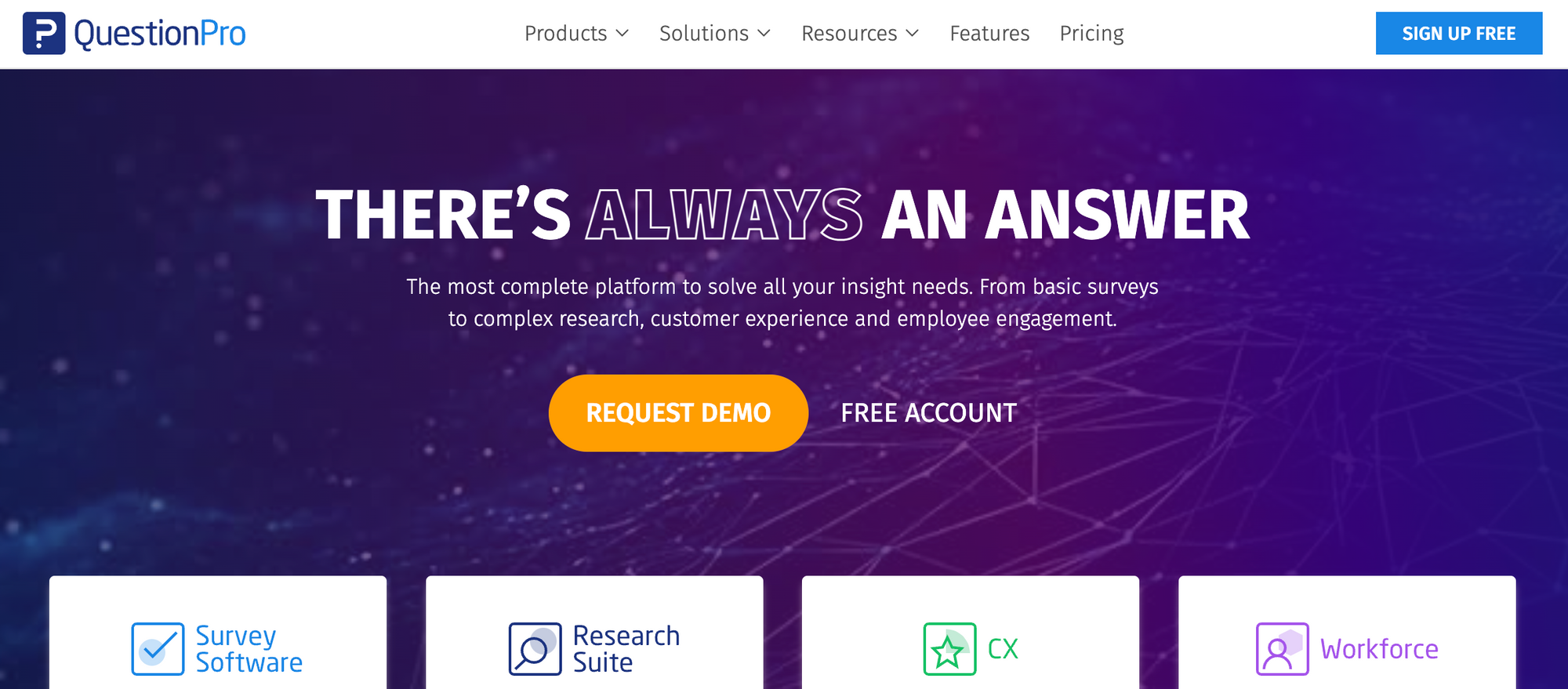
QuestionPro is a VoC survey tool that has many features to collect and analyze customer feedback. With its robust survey creation options you can design surveys with various question types, send them across multiple channels like email, social media or via custom links and even use advanced targeting options to reach specific audience segments.
One of the best features is QuestionPro’s built in analytics which gives you detailed data reporting and real time insights. It also has integrations with popular CRM’s so you can feed feedback into your overall business process.
QuestionPro G2 reviews:
“QuestionPro is an intuitive, easy-to-use program that has become a valuable resource to our organization. We especially appreciate the analytics component, which features nice graphics and helpful dashboards.”
“I was able to channel survey takers through my survey to make it more relevant to each taker and customize the experience.”
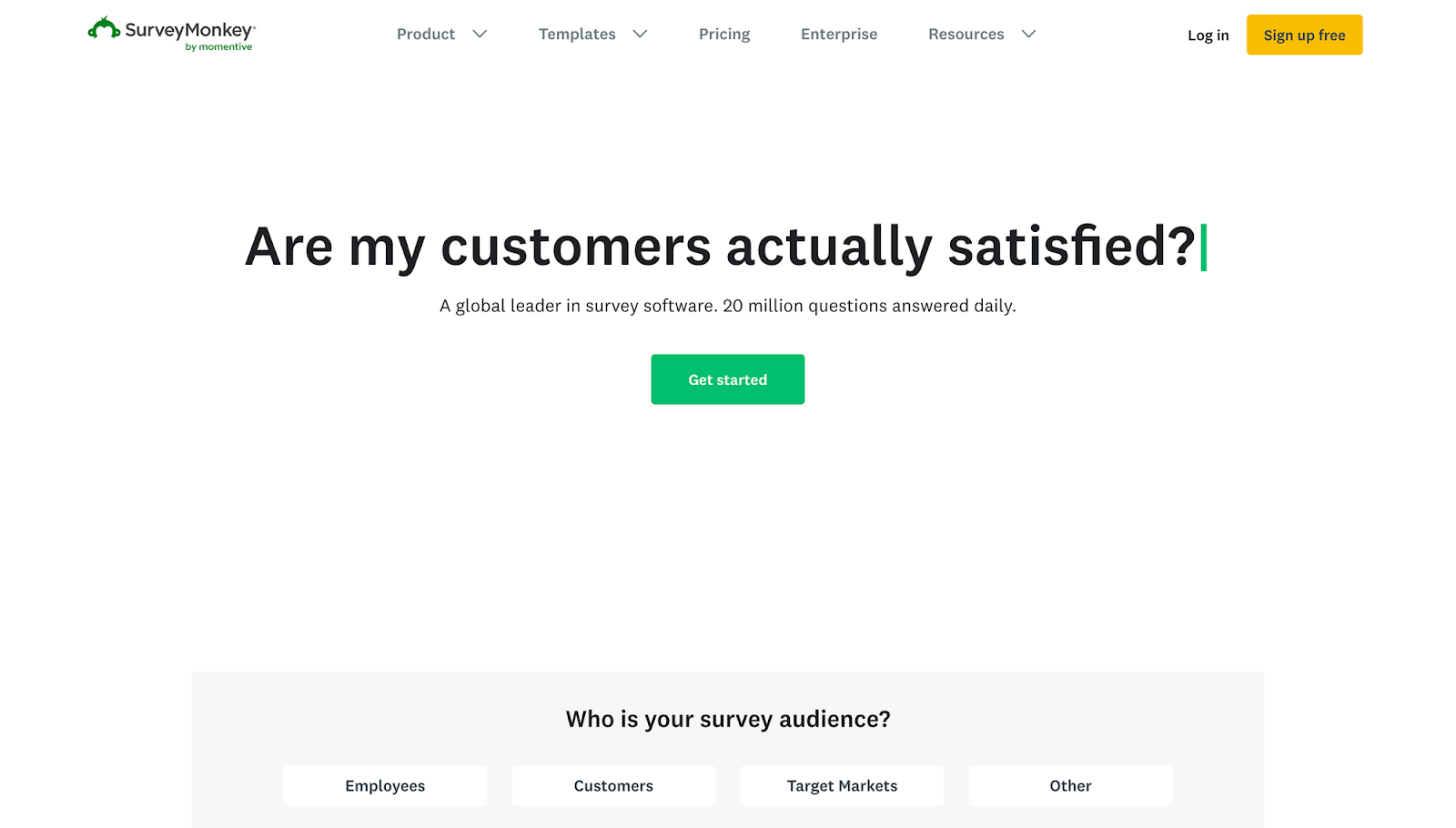
SurveyMonkey is a top VoC survey tool thanks to its ease of use and versatile survey creation options. You can choose from various survey question types, customize the design of their surveys, and distribute them via email, social media, by generating a QR code, or by other channels.
Benefits include its flexibility and user-friendly interface, which streamline feedback collection and analysis. However, it lacks the advanced analytics and integration features found in higher-end platforms, and some advanced tools are only available in paid plans.
SurveyMonkey G2 reviews:
“SurveyMonkey's intuitive user interface and extensive customization options for surveys are what I like best.”
“What I dislike about SurveyMonkey is that some of the more advanced features and detailed analytics are only available in higher-tier plans, which can be costly.”
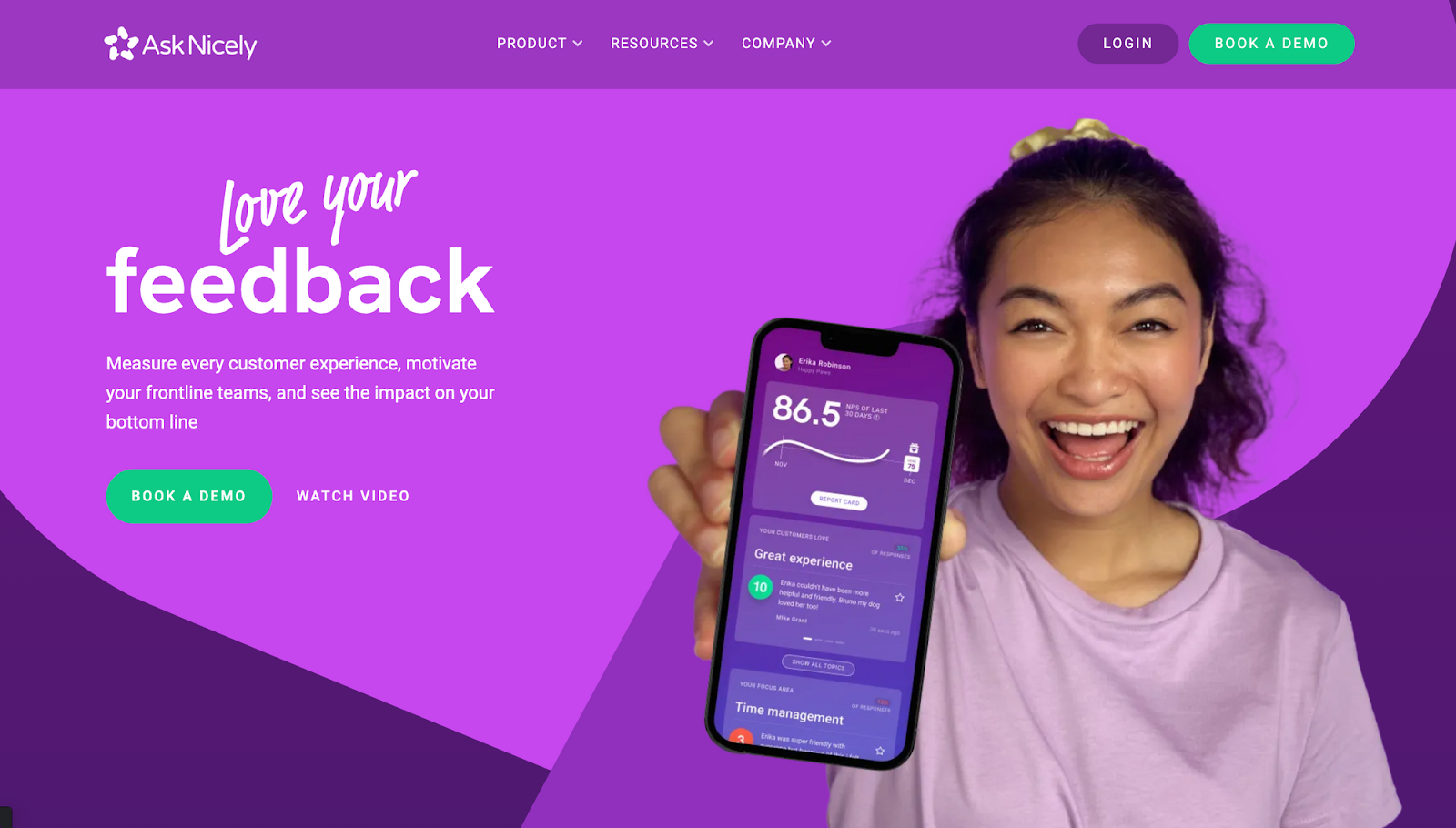
AskNicely enables businesses to automatically collect feedback from any point on the customer journey with quick and simple surveys.
The software is designed to connect your frontline to your bottom line. A unique way it does this is by letting you compare your team members’ performances at a glance. This makes it easy to spot what your highest performers do differently. Plus, you can accurately calculate how your increased CX has impacted your revenue.
AskNicely’s goal-setting feature is another unique perk. The system lets you set personal NPS goals and track progress from your phone. And since you can compare employees in the app, it also lets you show them appreciation.
Users generally find AskNicely easy to use, but some have mentioned issues with limited reporting functionalities and the built-in visualizations.
AskNicely G2 reviews:
“The system is very easy to set up and use. The features are well laid out and intuitive.”
“The built-in reports and graphs are not that great, so I find the best approach is to export the response excel and then go about creating reporting manually.”
Brandwatch is a top social listening tool that helps businesses track and analyze conversations happening online—whether it’s on social media, blogs, or news sites. It’s great for getting a big-picture view of what people are saying about your brand, spotting trends, and understanding customer sentiment.
A big pro is that Brandwatch gathers data from lots of different sources, so you get a comprehensive look at online chatter. It also has features like sentiment analysis and trend spotting that allow you to dig deeper into the Voice of the Customer. On the flip side, users have reported that it can take a long time for data to load, especially after updating queries.
Brandwatch G2 reviews
“Brandwatch excels in data collection and analysis, providing users with access to a vast array of social media data, forums, blogs, and more.”
”It goes beyond simple positive or negative categorizations, offering nuanced insights into the emotional tone of consumer conversations.”
“Sometimes data loading takes too much time.”
Talkwalker is another top social listening platform that helps businesses keep tabs on what’s being said about their brand. Talkwalker monitors a wide range of online sources, ranging from social media and news sites to forums, YouTube videos, and review sites, delivering a broad view of your Voice of Customer.
Reviewers tend to praise Talkwalker as a comprehensive tool to monitor brand presence, but others also mention that the price can make Talkwalker inaccessible for smaller businesses.
Talkwalker G2 reviews
“Talkwalker does a great job of monitoring the web and tracking your brand's presence.”
"It's a pretty expensive solution, not a great option for a business with a small budget."

Qualtrics is a comprehensive customer experience management (XM) platform. It offers various VoC tools, including surveys, feedback forms, and text analytics. Qualtrics can be a good VoC solution for larger businesses already using the platform since all of your data is already in one place. Reviewers have mentioned that integrating with other applications can be challenging.
The platform's depth and flexibility may present a learning curve for new users, and its pricing can be on the higher side making it more suitable for larger organizations with significant budgets.
Qualtrics G2 reviews
“It is easy to use, with a few clicks you can send a survey for your customers…”
“Qualtrics Customer Experience interoperability can be improved as it requires significant effort for integrating to other applications.”
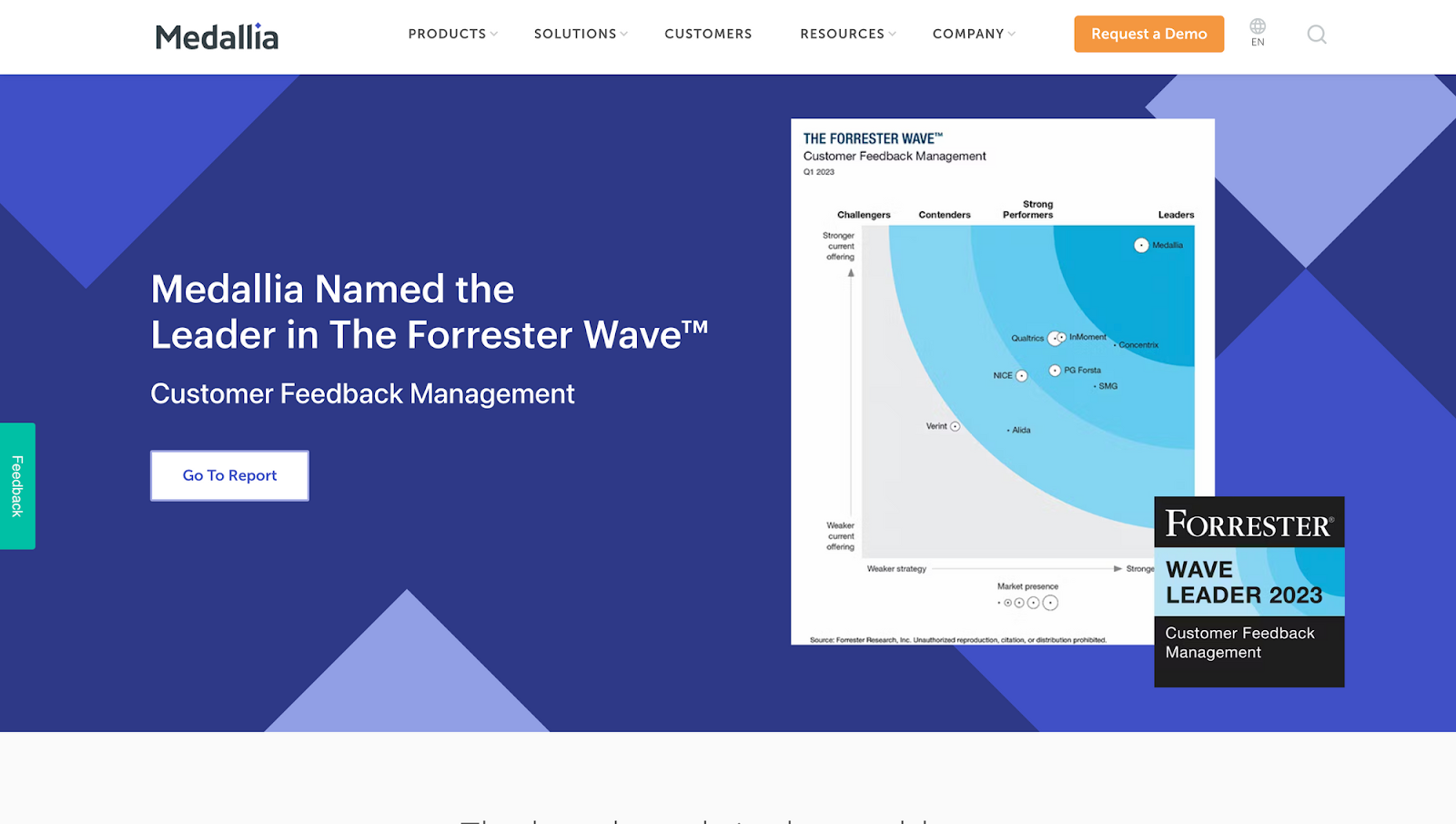
Medallia is a customer experience management platform that offers VoC tools such as surveys, social listening, text analytics, and more.
Its features give you a birds-eye view of the metrics you need to maximize customer experience. Monitor what customers are saying on social media. Store feedback from calls, emails, and other forms of communication for later analysis thanks to Medallia’s transcripts, speech analytics, and ticketing systems.
Medallia also boasts AI and machine learning tools that let you analyze structured and unstructured insights in a cinch. You can tap into data that reveals what your audience cares about most and predicts their buying behaviors. On the flip side, though, users have reported difficulties with analyzing unstructured feedback and reliance on third-party assistance to configure the platform.
Medallia G2 reviews
“The integration with other programs is simple and straightforward, particularly with the help of our Medallia Professional Services team.”
“The dependency on third-party to configure anything in the platform is challenging.”
“We’d love to see better analysis of unstructured data, leveraging AI and advanced text analytics tools. We still struggle to tell stories using their TA topics.”
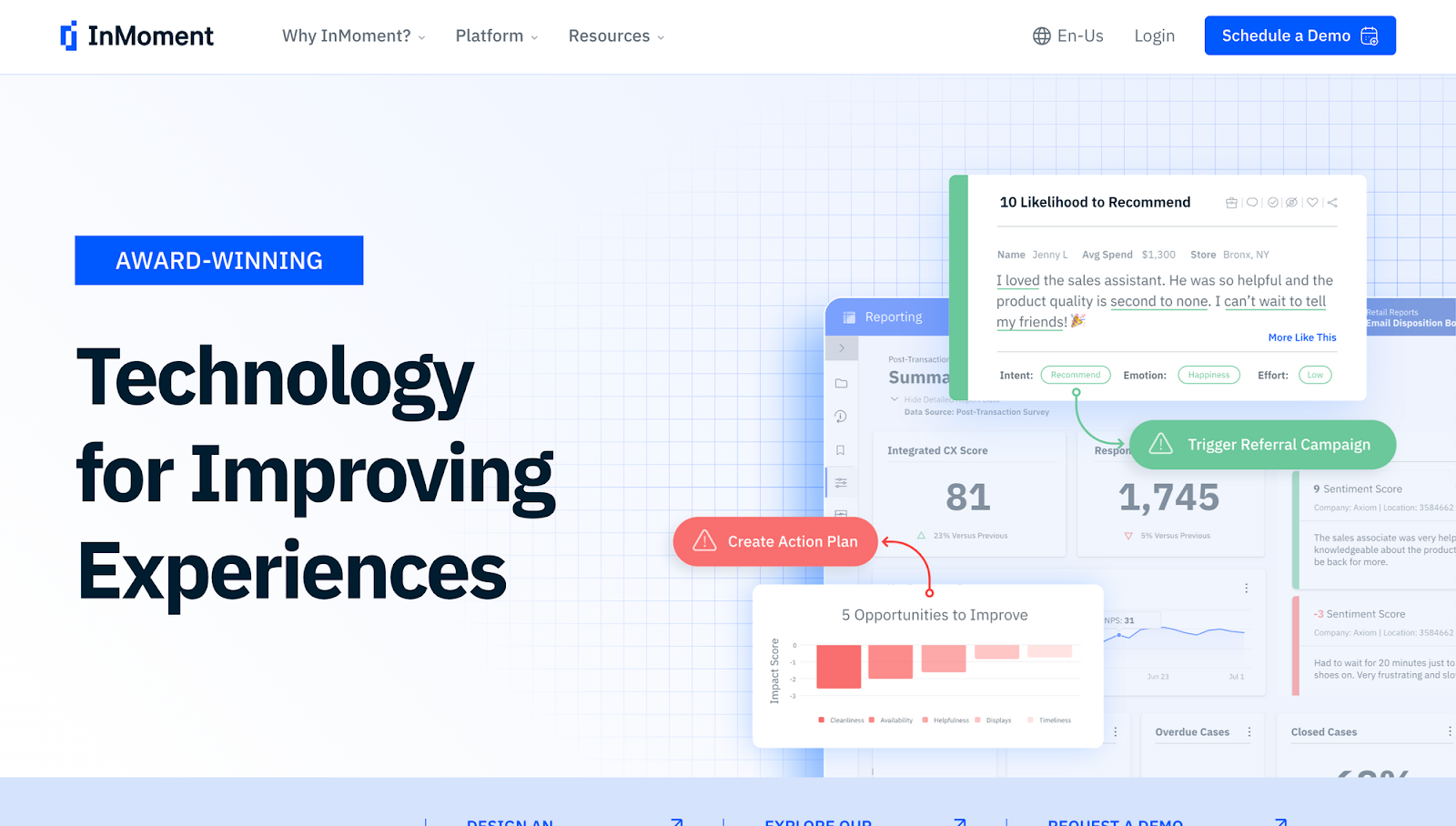
InMoment is another well-established integrated VoC solution that offers a comprehensive approach to understanding and enhancing customer experience. Like Qualtrics, InMoment excels in gathering and analyzing feedback from a variety of sources, including surveys, social media, and contact center interactions, to provide a holistic view of customer sentiment.
InMoment’s strength lies in its ability to combine multiple feedback channels into a single, coherent platform. But if you opt for the full-service option, you may find yourself waiting for changes to be made according to recent reviews. Users also mention that it can be tricky to find data for certain time periods.
InMoment G2 reviews
“InMoment helps us track customer experience by providing survey links for the customer and detailed reports for us.”
“Selection of data timeline and finding data for a specified time is really difficult.”
“Account managers aren't often able to make quick fixes for you, nor are you able to make changes (if you operate on the managed service model). Having a simple filter added to a report or a survey change made takes months.”
Verint is a customer engagement platform that offers VoC tools such as surveys, feedback forms, and speech analytics.
The platform is divided into four parts: digital-first engagement, experience management, workforce engagement, and open cloud platform.
Verint is a useful tool for VoC programs since it is relatively straightforward to gather data from multiple customers and analyze it within the platform. However, reviewers do report that Verint’s reporting is limited and support may be required for more advanced users.
Verint G2 reviews
“Verint VOC makes it easy to gather feedback from multiple customer groups on multiple topics at the same time.”
“Advanced reporting can be tricky. We usually need support for very detailed reporting such as the reports built for our major survey that goes out to our clients.”
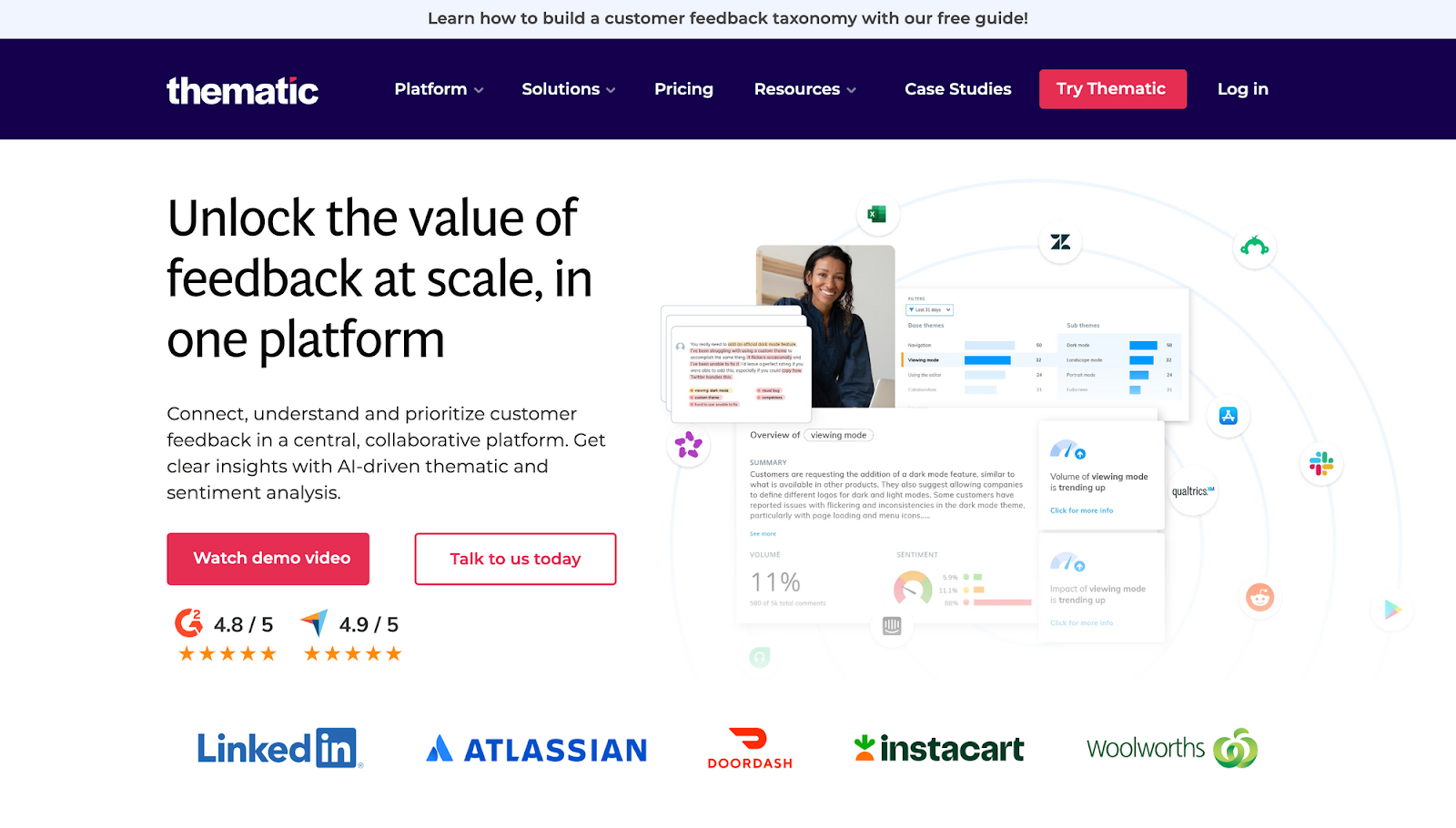
Thematic is an AI-powered platform that makes it easy for you to analyze customer feedback at scale. Thematic works by automatically identifying themes, or topics, in your data in real-time. These are divided into themes and sub-themes so you can instantly see which topics are most important to your customers.
Thematic’s clear visualizations make it easy to view the top themes in your VoC data, track changes, and understand customer sentiment. Thematic quantifies your qualitative customer data with metrics like impact on NPS score. You can easily drill down into your customer feedback data to see exactly what the problem is, and share this information with the right people in your organization.
As well as robust analysis tools and shareable dashboards, Thematic leverages Generative AI to continuously improve accuracy and adapt to evolving language patterns. Useful features include:
“It does an excellent job using a single view to break down the verbatims into themes displayed by volume, sentiment, and impact on our beacon metric, often but not exclusively NPS.”
“Their AI model does a great job to jump-start your categorization model with the ability to merge, tweak, add new themes quite easily.”
Try Thematic on Your Data
Still not sure which is the best VoC tool for you? Why not try out Thematic on your VoC data with a free guided trial and see how it works for you.

XM Discover is the AI analytics software that Qualtrics purchased from Clarabridge. So ideally you need to be gathering data with Qualtrics in order to use Discover XM.
To get started, you select a specific industry AI model and then begin training it to customize it to your business and market context. This means it can take weeks or months to start getting your VoC insights.
Reviewers have also reported that there is a steep learning curve when it comes to using the platform and how to analyze the data to discover insights.
“Our team did not have the expertise to fully utilize the features with this product.”
“A little bit of a learning curve to understand setting up and configure.”
“Requires a lot of admin time for set-up, onboarding, and maintenance.”
AI and NLP have transformed text analytics and made it easier than ever to understand your customers. So, what can we expect future VoC tools to offer?
One big trend is the increased integration of artificial intelligence (AI) and machine learning (ML). These technologies are enhancing VoC tools by enabling more sophisticated data analysis. This includes predictive analytics and advanced sentiment analysis which help businesses anticipate customer needs and issues.
AI-driven insights can identify patterns and trends that might not be immediately apparent, allowing for more proactive and informed decision-making.
As customer journeys become more fragmented across various touchpoints, VoC tools are developing to capture feedback from more and more channels. Future VoC tools will seamlessly collate and analyze data from everything from social media and messaging apps to voice-activated devices. Businesses need to provide a seamless and consistent experience, regardless of how or where customers choose to engage.
Future VoC solutions will offer more tailored interactions, customizing surveys and feedback forms based on individual customer profiles and behaviors. This personalization enhances the relevance of the feedback collected and improves engagement rates.
Businesses are shifting from periodic surveys to always-on feedback mechanisms that allow for immediate response and action. This means customer insights are current and actionable, enabling businesses to be more agile and responsive to evolving customer needs.
As companies seek to derive greater value from their data, VoC tools will need to seamlessly connect with BI platforms. This integration will allow businesses to correlate VoC data with other key metrics, offering deeper insights and fostering a more customer-centric approach to decision-making and strategy.
Still not sure which VoC tools are right for you? The best way to find out is to try them out for yourself. Why not start right here with a free guided demo of Thematic using your own data.
Join the newsletter to receive the latest updates in your inbox.